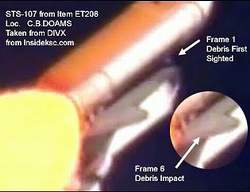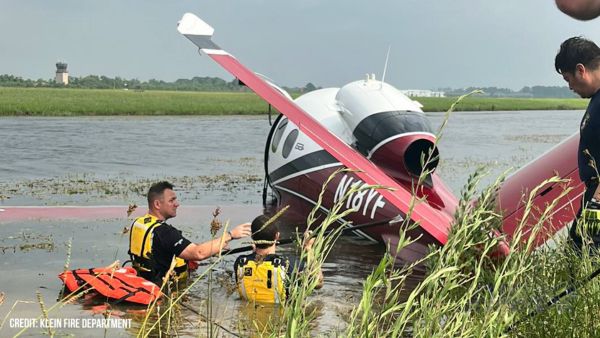Fri, Aug 01, 2003
CAIB Wants Pictures Can Help Troubleshoot Potential Debris
Issues
 NASA needs to see the
big picture when it comes to any future shuttle launches. That's
the recommendation of the Columbia Accident Investigation Board
(CAIB), which says high-resolution photos of the tank taken during
lift-off could help avoid another debris-related disaster. Columbia
disintegrated February 1st as it re-entered the atmosphere at the
end of a two-week long mission.
NASA needs to see the
big picture when it comes to any future shuttle launches. That's
the recommendation of the Columbia Accident Investigation Board
(CAIB), which says high-resolution photos of the tank taken during
lift-off could help avoid another debris-related disaster. Columbia
disintegrated February 1st as it re-entered the atmosphere at the
end of a two-week long mission.
The CAIB, charged with reporting to lawmakers and the American
people on how that could happen, says debris shed from the external
fuel tank probably punched a hole in the orbiter's left wing. That,
they theorize, allowed super-hot gases to melt critical parts of
the shuttle, eventually leading to its destruction. All seven
astronauts on board were killed.
"Imaging the space shuttle system during launch and ascent
provides necessary engineering data including the ability to
examine the space shuttle system for any unexpected debris or other
anomalies during ascent," the board said on its web site, www.caib.us.
All three remaining shuttles have cameras on board capable of
imaging the external fuel tank. The problem is, those pictures can
only be downloaded after the shuttle's mission is complete. One of
the board's recommendations, expected to be finalized by the end of
the month, will be for NASA to concoct a way to beam those pictures
back while the shuttle is still in orbit. That way, if there's any
sign of debris flaking off the external tank, engineers can figure
out what sort of damage it caused and how that damage should be
addressed.

The recommendations released Wednesday mark the fifth time the
CAIB has spoken out on its ideas for making shuttle flights safer.
The board also suggests the International Space Station be used as
an emergency repair facility should the space planes find
themselves in orbit, unable to land.
But that wouldn't have helped Columbia. As the first shuttle put
into service, it was simply too heavy to make the trip 240 miles
into space for a rendezvous with the ISS. In fact, the CAIB
has yet to say what, if anything, might have saved STS-107.
More News
“Warbirds in Review features veterans, aviation legends, and aircraft that simply cannot be seen together in one place anywhere else in the world. Many of these veterans main>[...]
Also: VAI v Anti-Heli Actions, Electric Aircraft Symposium, 2024 FAA Drone/AAM Symposium, Gravitymaster Blue Origin's seventh passenger flight ended with a smidgeon of drama when o>[...]
“The importance of this YF-16 paint scheme is celebrating 50 years of the F-16 Viper. Everyone at Edwards has a big sense of pride for not only supporting the Viper Demo Team>[...]
Aero Linx: National Aeronca Association We are dedicated to supporting the design and preserving the history of Aeronca aircraft. Founded by Jim Thompson and fostered by his leader>[...]
Klyde Sounds Like He's Defining An 'Influencer' FMI: www.klydemorris.com>[...]
 Aero-News: Quote of the Day (05.25.24)
Aero-News: Quote of the Day (05.25.24) Airborne 05.22.24: NS-25 Chute Failure, #HonorTheWASP, SkyCourier 'Combi'
Airborne 05.22.24: NS-25 Chute Failure, #HonorTheWASP, SkyCourier 'Combi' Aero-News: Quote of the Day (05.26.24)
Aero-News: Quote of the Day (05.26.24) ANN's Daily Aero-Linx (05.26.24)
ANN's Daily Aero-Linx (05.26.24) Klyde Morris (05.24.24)
Klyde Morris (05.24.24)




